Combating Climate Change: A summer workshop for children
Download pdf version of Report here.
Images from DNA coverage of the workshop
19 – 23 April 2010
With rising April temperatures in the city and summer vacations having just begun, a group of 21 children representing many schools in Bangalore and coming from many neighbourhoods in South Bangalore actively participated in a five day summer workshop organized by the Environment Support Group (ESG) at the ESG office in Bangalore to understand the complex issues of Climate Change and global warming and learn how to combat the same.
Introductions through a game…
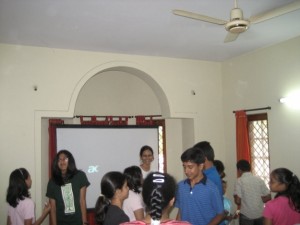
The first day of the workshop commenced with a little game through which the children introduced each other and in the process got to know one another. The game was coordinated by Gomati Madaiah and Shruthi Subbanna. Once they got familiarized with each other Bhargavi S.Rao engaged them in an interactive discussion on how and why the planet was warming and what were the impacts of climate change. This was followed by a very illustrative slide presentation by Sruthi on Global warming, Climate change and the different sources of carbon. Sruthi also engaged the children in an energetic discussion on the alternate ways of living and how we can all play a part in minimizing carbon emissions. Following a small break Gomati engaged the kids in a game to help them learn the common terminologies associated with climate change.
Conversations about carbon emissions adding to air pollution gradually led to discussions of ways to minimize the emissions and regulation with respect to pollution. Bhargavi introduced the children to some of the basic environmental laws and the role of the Pollution Control Board as the regulatory agency. Case studies of illegal dumping of municipal solid waste, biomedical waste and industrial waste were cited by Sruthi to explain how individuals, organizations and students can complain about such environmental problems to the Pollution Control Board. She also explained the different case studies and the actions initiated by the Board through a slide presentation. The children along with the ESG team discussed some of the challenges of regulation and punishment to the violators.
Visit to the pollution Control Board
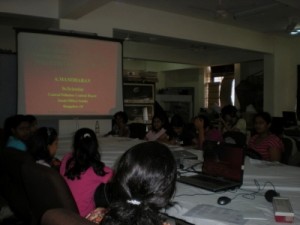
Post lunch the group visited the Karnataka State Pollution Control Board office at Parisara Bhavan, in Basaveshwarnagar. Though the objective of the visit was to have a interactive discussion on the role of the KSPCB, the air monitoring stations, the parameters monitored and the regulatory action taken by KSPCB the authorities at the Parisara Bhavan had organized a slide presentation about the environment and the kids were given a lecture explaining the different aspects of pollution. Some of the pollution monitoring instruments were also on display and the children enjoyed the Noise level indicator as they screamed into the instrument to check their decibel levels.
The second day commenced with children sharing their experiences at the pollution control board. Mr. Leo F. Saldanha on hearing their experiences articulated the need for children to be aware of their environment and highlighted the need to strengthen our regulatory systems to be able to handle environmental disasters and emergencies such as the Bhopal Gas Tragedy. He narrated the events leading up to the tragedy, explaining how carelessness and callousness by industrialists such as DOW Chemicals can impact human health. He explicitly described how such criminal actions get away with meager compensations that never really reach the impacted communities. He elucidated the need for citizen action in making the regulatory agencies more efficient and responsive.
In an attempt to have the kids get to know each other a little better Sruthi and Gomati had them play a short fun activity consisting of finding participants in the workshop with similar interests to their own. After a short break to sing ‘Happy Birthday’ for Sruthi and relishing the birthday cake the children regrouped together for an Earth quiz that was conducted by Gomati. This was followed by a short interactive slide presentation by Sruthi on alternate sources of energy, alternate modes of transport and how we can reduce emissions. Sruthi highlighted the case of Bangalore’s road widening project that was adding more cars to the roads, while it was mindlessly removing the urban green cover thereby adding more to the existing problems of global warming and climate change. She also stressed how such projects were insensitive to the needs of the urban poor and their livelihoods.
Eco-friendly lifestyles

Bhargavi spoke to the children about the changing lifestyles and the changing patterns of consumption and waste generation since the time of our forefathers. She stressed the need for living an eco friendly lifestyle that did not cause much damage to mother earth and gave an idea about how such a life could be made possible through building and living in eco friendly homes. She illustrated this through a slide presentation of Mr.Chokalingam’s home on Bannerghatta road that has been built based on the Harappan and Mohenjodaro designs with provisions for free flow of fresh air and escape of warm air. She explained how the house had been built with bricks made locally and used old recyclable doors and windows. She also highlighted the use of solar power for all power needs, composting of waste, harvesting rain water and the many innovative ways of reducing carbon footprints that has been incorporated in the house.
After lunch the children were excited to visit the eco-friendly home of Mr. Jaideep and Ms. Latha in Rachanamadu village off Kanakapura road. The Children were enchanted when Latha explained to them how the site which was now filled with Fig, Plumeria, Coconut, Lime and many other trees was a barren land just a few years back. She also explained how they nurtured the trees, and tended to their vegetable garden that supplied fresh organic vegetables to their daily menu. Mr. Jaideep explained to the children about the rain water harvesting pits present in their garden and how it helps recharge the ground water. He also showed the waste water recycling through reed beds and filters that was being used for the garden. The peddle pump used to draw water from the grey water well caught the attention of the children and each of them gave it a try. In addition Mr. Jaideep showed the children the roof top rain water harvesting and how it was collected in a sump after filtering through a sand bed filter. The kids were also fascinated by the way the toilets in the house were altered so that one of them utilized the waste water from the washing machine while the other toilet was a dry one in which the waste would be later utilized for making manure. Many of the children were also charmed by the use of bamboo for wardrobes and the cool flooring made of red and green oxide.

After a complete tour of the house the children sat with Mr. Jaideep and Ms. Latha for an informal discussion and Mr. Jaideep highlighted the need for rain water harvesting in all of Bangalore’s homes. He also pointed out how most urban residents used a hose pipe to wash their cars unmindful of the fact that in the urban fringes of Bangalore, women had to stand in queue for long hours just to get one pot of clean drinking water. Mr. Jaideep also stressed the need to eat locally grown food grains, fruits and vegetables that were far healthier than those fruits that traveled across the world with lots of chemical sprays to keep them look healthy and fresh. After a refreshing fruit drink the children joined Ms. Latha for a walk in the neighburhood up to “Pig’s rock” as it’s popularly known and she explained how a small stream flows in the region for most parts of the years except during the peak summer months. Children enjoyed walking around observing the big termite hills, the trees and the rocks. Cloudy skies and a few drops of rain alerted the children and they quickly got into the cars to head back home.
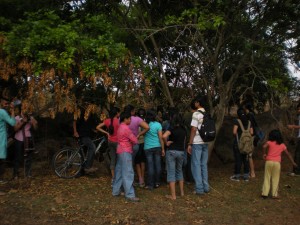
On the way back, the group stopped at the Shetty Halli Kere and Bhargavi explained to them briefly about the history of tanks in Bangalore, the structure of tanks, their function and their present status. She also helped them see for themselves the entry of sewage from the newly built apartments into the Shetty halli tank that was enriching the tank with nutrients thereby increasing the growth of water Hyacinth. The children also observed a variety of water birds such as the Purple Moorhen, Cattle Egrets, Pond Herons, Jacanas and a few others. After observing the tank for a short while the group returned to the ESG office full of wonder and inspiration.
Climate Change, Lives and Livelihoods
The third day began with sharing of the previous day’s experiences at the eco-friendly home and the tank which was then followed by discussions of some case studies from around the world about how climate change impacts lives and livelihoods. Through a slide presentation Bhargavi showed the children how communities in Bangladesh, Nepal and Peru were coping with the natural disasters of floods, landslides and food insecurity.
This was followed by the story of the Bamboo weavers in Bangalore. Sruthi explained to the children how a growing metropolis plans infrastructure projects such as the Metro without due consideration of the urban poor and without any public involvement. She highlighted the fact that the current alignment of the metro would serve a very small percentage of people in Bangalore and its construction was also happening at the cost of many lives and livelihoods. She elucidated how that this would displace communities that had been living in some parts of Bangalore from time immemorial. She explained how the Bamboo weavers community that lives on K.R.road were thrown out of their homes when the Metro construction began without any due consideration even to the women and children. She also talked about how this community continues to live on the construction debris and the broken pavements in dangerous conditions, with each day being a struggle. The story helped children think of alternate plans and how planning a metro underground could save many people their lives, homes and livelihoods.
Post this session the children learnt about making recycled paper at home and designing rain water harvesting units for their homes. The kids were taught how to calculate the amount of rain water they can collect based on the roof area through a very simple formula. They were encouraged to speak to their parents about the possibility of implementing rain water harvesting units at their homes.
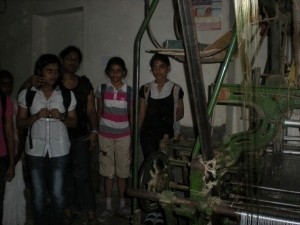
A game of Chinese Telephone co-ordinated by Gomati was followed by lunch time which was once again a fun time as there was another birthday at ESG, the children sang happy birthday to Gomati and also enjoyed some refreshing ice cream. The afternoon was spent at a Silk and rayon weaving unit in Sampangiramnagar understanding the functioning of power looms in an era of growing debates and discussions about reducing emissions to combat climate change. Children were guided through very narrow stairways that lead to a hall that had rayon yarn twisting machines. Mr.Gopal, the proprietor of the unit explained how the rayon yarn was imported from Germany and it was further twisted here through spinning machines to a desired thickness to weave sarees.
The twisted yarn was then fed into power looms to weave sarees that would later be dyed and printed. He explained how each power loom made approximately 4 to 5 sarees, sometimes even 6 per day. Each loom needed only one person to monitor and there were about 34 such looms that operated throughout the day except in the night. Mr. Gopal also shared that the electricity bill per month was nearly about RS.15,000/- at a subsidized rate. The cost of each saree at the market was about Rs. 300 –Rs.400/-. Children watched with great enthusiasm the precision in weaving the many self embossed designs by the huge machines while they wondered how the same would be done manually by the handloom weavers.
As we walked out of the noisy setting of the weaving unit, children had lots of questions about silk and cotton yarns, the silk sarees and the dyeing process. Many even wondered whether the silks they had seen at home were handloom or powerloom, they discussed the softness and coarseness of the silk sarees. It also left them wondering about which of the two (handloom or powerlooms) is environmentally more feasible?

Children understood how the powerloom is a big threat to the existence of traditional skills and livelihoods. The cacophonous cluttering noise emanating from all the buildings around left the kids wondering about the dwelling conditions there. The serene sound of the handloom weaving is not heard anywhere around the neighbourhood as all the families have shifted to powerlooms. Bhargavi shared with the children that the use of power loom for making a saree looking almost identical to a traditional handloom saree has made many of these traditionally skilled weavers redundant. Not only has the skill become redundant but the weavers also have become redundant and without jobs, as the power loom require less people and less time in making a power loom saree. She explained how one handloom saree, which takes about 10 days on a handloom, can be replicated (although nowhere near the same quality) within a few hours only. This way, one power loom replaces about 10 weavers. She further explained that with the power loom itself, from designing to weaving and even embroidery work is accomplished reducing the elements of skill and human intervention to a great extent.
A morning at a forest
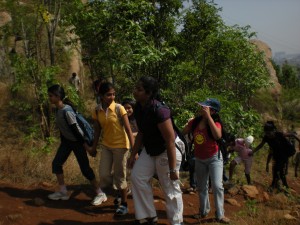
Thursday saw a bright and early start to the day with a field visit to a patch of forest, Turahalli to demonstrate the ecology and biodiversity present in that forested area. Children arrived bright and early and the group left for Turahalli by 8.45 am accompanied by Sruthi, Mallesh and Bhargavi. Turahalli is a dry deciduous forest on the outskirts of Bangalore in the south. It lies adjacent to the Kanakapura Road and is about 10 kms from Banashankari 2nd stage. The forest has a good variety of flora and fauna. Parts of Turahalli have been afforested with Acacia and Eucalyptus. Children enjoyed trekking up the Turahalli hills from the northern side. They observed many insects and lizards. On reaching the highest point they enjoyed the view of the city and were able to understand the scale of development in and around the hills. They were thrilled to try rock climbing and did manage to climb most of the rocks.

After exploring the region the group settled down and discussed a few issues about the benefits of trees and forests. Bhargavi described how water moves up the trees through the roots and how the root system spreads far wider than the canopy seen above ground. She emphasized the importance of trees in holding the soil and in creating water sheds in such regions. She also mentioned that the region is known for wildlife such as the Great horned owl, Mongoose, Jackals and is also part of an elephant corridor of the region. As the mid morning sun got warmer the group observed a variety of butterflies hovering in the area. They also observed a large group of kites flying above closely keeping a watch over the smaller forms.
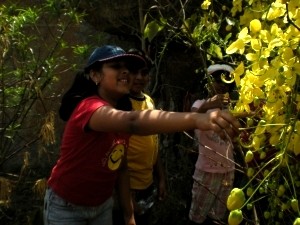
They explored deeper into some of the rock formations with Sruthi’s constant encouragement and supervision. They discovered caves through which they climbed up and found their way to the top most point and were completely enchanted at the beauty of the rocks. The descend down the hill was filled with watching a few butterflies, birds like the Drongo, Mynas, Flycatchers and a few were lucky to spot a Cicada on a young eucalyptus tree. The call of the Cicada was deafening and while children observed it Bhargavi explained to them that the Cicada’s call is the loudest song of the insect world and that it is only the males that sing, trying to attract females for mating through ribbed membranes on either side of the insect’s abdomen. While the sun by noon got really hot and the water bottles got completely dry the three cars were filled with chirpy chatter as the vehicles made their way back to the ESG office.
On returning to the ESG office Bhargavi gave a brief explanation of the science behind genetic engineering and the social and economic factors associated with genetically modified food, taking BT Brinjal as an example.
Watching documentaries
The kids were then shown three documentary films on various issues. The first being “Nagara Nyrmalya”, a film on how segregation of waste at home could help solve the massive problems it causes when all accumulated together. Bhargavi also further explained in detail the different types of wastes and the ill effects associated with their improper disposal such as leaking of leachate and pollution of water bodies. The kids were also taught how waste can be composted at home through a very simple method in an old bucket using brick, bagasse and charcoal by two of the participants, Kailas and Aishwarya with Bhargavi’s encouragment.

The second documentary film illustrated the fading of the Dharmaboodhi lake. The Majestic bus stand in Bangalore now stands in place of where the lake used to be. The film demonstrated the issue of the pollution of lakes in Bangalore and how the negligence of these valuable water bodies has lead to Bangalore no longer living up to the name of the city of a thousand lakes.
The hardships faced by the coastal regions as a result of global warming were then highlighted in the film “A Climate Call From The Coast”. This short film concentrated on the rising sea levels and the adverse effects they had on fishing communities using Kerala as an example. The documentaries helped introduce a multitude of social and environmental issues to the children in a comprehensive manner.
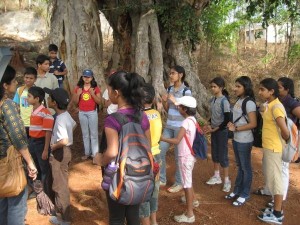
The final activity of the day was a game based on role playing wherein the kids were divided into teams with each team representing the voice of a particular organization. The organizations they represented were Monsanto: the company behind the implementation of BT Brinjal, a group of villagers who’s land is threatened by implementation of GMO’s and establishment of industries, a government panel to listen to the proposals put forward and come up with a binding decision and a Paper mill company and a Nuclear Power plant, both keen on establishing their industries in the village. Each “organization” argued their case and the children had a lot of fun with the squabbles that ensued. Some of the interesting ideas included “Monsanto” offering the villagers an attempt to genetically modify the trees that the “paper Mill” wanted to cut down and the “villagers” declaring that they did not require paper from the mills and were instead content to live the rest of their lives utilizing slates! In an attempt to bring an element of reality into the picture some of the “organizations” even tried holding an auction to bribe the “government officials”!

All ended well though with the “government officials” ruling in favor of the “villagers” declaring no permission for Monsanto and the Nuclear Power plant to establish their industries and granting permission for a small paper mill to be established which complies with the standards for pollution control.
The workshop on Friday was aimed at providing a platform for the participants to think of solutions to everyday problems faced in metropolitan areas. The workshop started off on a light note with Shruthi having the children participate in some fun quizzes about animals and the environment which also proved to be a learning experience for them.
Understanding governance and the importance of influencing decision makers
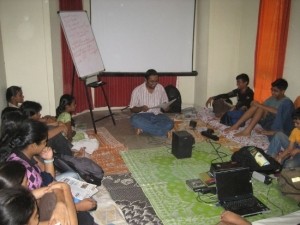
Mr Vinay of Hasiru Usiru was the guest speaker of the day and started off the discussions by engaging the children in an interactive session about the traffic congestion problem in Bangalore. It proved to be a very informative session for the children allowing them to brainstorm alternate ways of solving the congestion dilemma. Some of their suggestions included carpooling, encouraging cycling and increasing the number of public transport facilities on the road. Vinay was very impressed with the simple but efficient suggestions that were put forward, suggesting that if the participants were members of the government Bangalore’s congestion woes would have been eased in no time at all!
The children were very surprised upon learning of the statistics that about three lakh private vehicles were registered in Bangalore everyday while in contrast only three hundred buses were registered every year! Vinay went on to explain that the government was turning to felling trees for both road widening and implementation of the Metro instead of looking towards a grass-root solution through increasing and improving the quality of public transport.
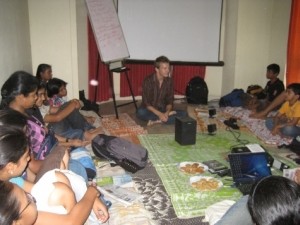
Mr Vinay also spoke to them about the importance of influencing the decision makers such as our elected representatives. He shared his experiences about the recent BBMP elections in Bangalore and the efforts in drafting a people’s manifesto by many voluntary organizations and individuals from the city to make it comprehensive to ensure all sections of the society are benefited by it. He also shared the experiences of meeting many of the candidates who stood for the BBMP elections and how a few of them incorporated many of the ideas into their own party manifestoes.
Mr Vinay presented each one of the children with the peoples manifesto for the BBMP 2010 elections, a document of progressive policies and measures that many not for profit, voluntary, public interest organizations and communities have come up with an attempt to provide the people of Bangalore an overview of what the candidates of the BBMP elections should ideally provide them with, in keeping with their rights as citizens. Each of the participants had an opportunity to go through the Peoples manifesto and paid keen attention to the section on children’s rights as Vinay stressed on the fact that not being able to vote does not disqualify them from demanding that their rights be given to them.
Following this, Jake Carlson, researcher from the University of Minnesota and an intern at ESG, spoke to the children about how to be an eco conscious and responsible tourist? He shared many of his experiences of traveling in the north and some parts of southern India and how important it is to be culturally and socially sensitive to the people of the different regions. He highlighted the implications of traveling by public transport as much as possible and the minimal use of non biodegradable materials while traveling.
After a short break, a discussion on corporal punishment in schools and the right of every child to report such instances was then started of by Bhargavi. Bhargavi talked to the children about the National Commission for Protection of Child rights and the State commission for Protection of Child rights and the functions of these bodies. The children were urged to bring to the attention of the school authorities and management if they witnessed any inhuman treatment towards children in School and they were also insisted to at least bring such incidents to the attention of voluntary Human rights associations such as/and to ESG if at any time they or any friends of theirs were subject to abuse at any level from prominent figures at their schools.
More games to understand the challenges of climate change

Upon breaking for lunch the kids took part in a fun activity to learn about working together for a common cause. The game took place on the lawns of ESG and had each of the kids sitting cross legged on the ground back to back. They all linked arms and on cue tried to get up off the ground at the same time without breaking the formation. It was a fun filled activity with some kids tumbling to the ground but still trying their best to not break formation. It put the kids in a lively mood and their squeals of laughter could be heard throughout the ESG office. Gomati then explained to them that life functions much like the way the game does. When working towards a cause, in order to get results in our society we need to make our voices heard by joining forces with like minded individuals. No group can function with each person working according to their own vested interests. Instead, everyone needs to work in unison towards the goal or face the tumbling effects of having the group break up and the aim never achieved.
The lively activities continued with a game of twenty questions co-ordinated by Sruthi and Gomati of ESG. The kids divided themselves into two teams and even established fun names for their respective teams. Each team came up with various words related to what they had learnt in the duration of the workshop and had the other team try to guess what the word was through asking twenty questions in a span of five minutes. The game proved to be quite enjoyable for all the children.
A final documentary “Tiger: The Death Chronicles”, about the extinction of tigers in India and the suspicion that the tiger reserves were failing to ensure their survival was shown to the participants. The documentary was a thought provoking one and introduced a new angle to the entire issue of preserving tigers in India.
A brief introduction to Disaster Preparedness
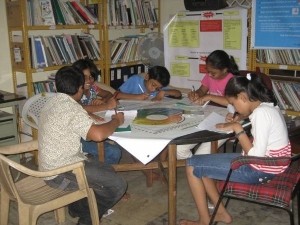
Prior to Lunch children were given a brief introduction to climate change related disasters and how to be prepared for disasters and prevent disaster damage. Children were briefly taught to make emergency information charts for their homes, neighbourhoods and schools with emergency information and contact details to be able to handle disasters such as Fires, Urban floods and other such possible disasters. Children were walked through a series of Posters that were on display at the ESG office on managing urban disasters such as fires, earthquakes, floods and these posters illustrated the need for emergency information and some basic training to be able to save oneself and other lives in times of such disasters. Going through the posters was very informative to the children as it facilitated the need for greater awareness and access to all the emergency contacts to be able to mitigate and manage a disaster.
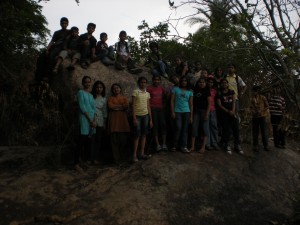
The kids were then asked to write individual feedback of their opinions about the workshop and ways in which it could be improved. The workshop ended with a vote of thanks by Bhargavi to everyone that was involved in helping make it a success. A special vote of thanks was extended to the children for being such an outgoing, curious and participative bunch helping to make the workshop one to remember for a long time to come.
The certificates of participation were then distributed after which the children exchanged contact information and stayed back at the ESG office reminiscing about the fun the past few days had bought them. They left with eager promises to return to ESG and also do their part to help make the planet a more environmentally and socially friendly place to live for generations to come.
[ This report was compiled by Gomati Madaiah and Shruthi Subbanna with inputs from Bhargavi S. Rao and Leo F. Saldanha.]

